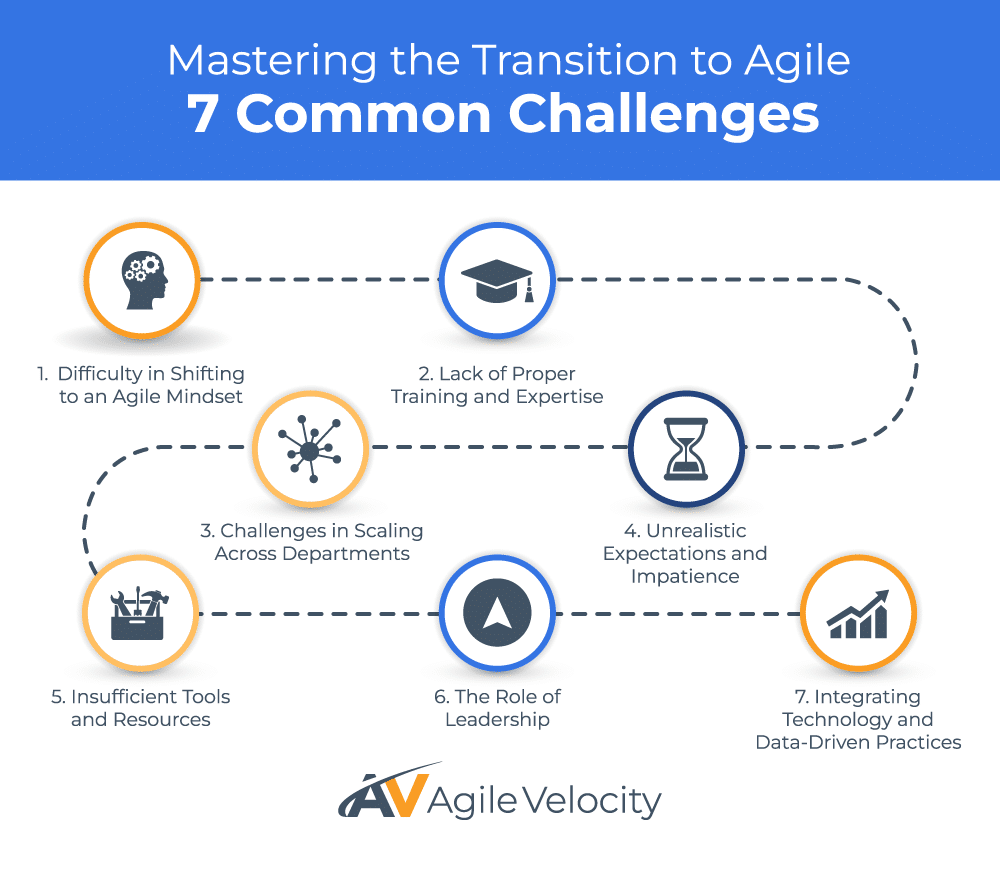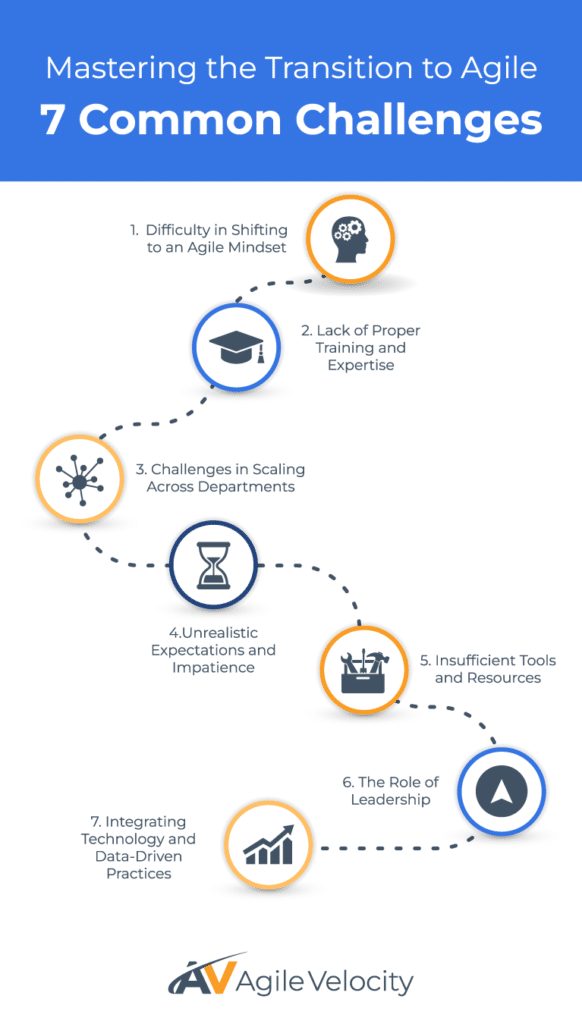Embracing Agile is more than just adopting a new methodology—it’s a fundamental shift in mindset, workflows, and collaboration. While Agile enables teams to deliver value faster and adapt to change, many organizations struggle with common adoption challenges. This article explores seven key hurdles businesses face when transitioning to Agile and provides actionable strategies to overcome them. Whether you’re a business leader, technology manager, or decision-maker, these insights will help you navigate Agile transformation with clarity and confidence. .
Agile is more than a set of frameworks—it’s about embracing a mindset of continuous improvement, collaboration, and adaptability.
Read on to learn how to transform obstacles into opportunities and unlock the full potential of Agile practices within your organization.
Understanding the Importance of Identifying Agile Adoption Challenges
A well-executed Agile transformation accelerates project delivery, enhances team collaboration, and improves adaptability in a fast-changing market. However, for organizations embarking on this transformative journey, acknowledging the roadblocks they may encounter is crucial. Awareness of common Agile adoption challenges enables businesses to proactively address obstacles that could hinder their progress.
Recognizing these challenges early allows teams to craft targeted solutions that streamline Agile transformation, ensuring a seamless transition and maximizing its benefits..


1. Shifting from Traditional Thinking to an Agile Mindset
One of the toughest challenges is changing the way people think and work. Agile requires a mindset shift from rigid management structures to a culture that thrives on collaboration, transparency, and continuous iteration.
Causes of Resistance
Resistance often arises when teams and leaders are comfortable with established routines. Agile’s iterative planning, self-organizing teams, and collaborative decision-making may appear risky or unnecessary. Many see Agile as just a trendy approach rather than a transformative mindset.
Addressing the Misconceptions
The common mistake is viewing Agile as a rigid framework. In reality, Agile is flexible and adaptable. It is not limited to software development but can enhance operations across all departments by promoting regular feedback and incremental improvements.
Fostering the Mindset Change
To shift the organizational mindset:
- Promote Openness and Transparency: Encourage open communication across every level of the organization.
- Engage Agile Coaches: Experienced coaches can guide your teams to internalize Agile values and practices.
- Clarify Objectives with A Clear Roadmap: Utilize tools and software that can help organizations map out clear transformation objectives, turning abstract goals into actionable steps.
If you are seeking advanced guidance on how to shift from older processes, professional guidance in leading Agile change management can help you set the stage for a smoother transition. Leaders can drive change by modeling Agile behaviors and consistently reinforcing new expectations. Over time, as teams see the benefits of frequent collaboration and iterative delivery, skepticism diminishes and enthusiasm for experimenting with new ways of working grows stronger.
2. Lack of Proper Training and Expertise
Agile adoption can fail when teams lack a deep understanding of its principles and practices. Comprehensive training is essential—without it, teams risk misinterpreting Agile principles and applying them inconsistently.
The Training Gap
Many teams may receive only brief workshops that do not instill long-term knowledge. Without ongoing learning, teams revert to old habits. Managers and team members alike must understand how Agile practices—such as Sprints, Daily Scrum events, and Sprint Reviews—translate into better outcomes.
Building Internal Expertise
While external consultants can jump-start the process, sustainable success relies on building in-house competency:
- Invest in Targeted Training: Offer role-specific workshops for Scrum Masters, Product Owners, and other key roles.
- Emphasize Continuous Learning: Implement regular feedback sessions and Retrospectives to refine Agile practices.
- Align Leadership: Provide Agile leadership coaching so executives set the right example for the organization.
By developing internal centers of excellence and communities of practice, your teams share learnings, challenges, and tips in a supportive environment. This framework ensures Agile practices take root and thrive long after any external consultants have departed.
3. Challenges in Scaling Agile Practices Across Departments

Expanding Agile beyond a single team introduces cross-departmental challenges that require alignment and strategy. Different departments often have varying processes, cultures, and goals that can hinder a unified Agile approach.
Barriers to Scaling
- Departmental Silos: Units may focus on their own objectives, leading to misalignment across the organization.
- Inconsistent Implementation: Without agreed-upon principles, different approaches (Scrum, Kanban, or SAFe®) can yield uneven outcomes.
- Resistance at Scale: Leaders and teams may be reluctant to adopt methods requiring significant structural or cultural changes.
Strategies for a Unified Approach
- Implement a Scaled Framework like SAFe: This approach aligns teams using Planning Interval (PI) Objectives and an Agile Release Train.
- Foster Cross-Department Collaboration: Use shared Iteration Objectives to align efforts across entire business units
- Explore Alternatives: Consider frameworks like SAFe or Large-Scale Scrum (LeSS) for scaling and to navigate cultural transitions.
Breaking down silos and fostering cross-functional collaboration is key to successfully scaling Agile. By establishing interdepartmental councils or cross-functional training sessions, you can promote alignment and ensure that Agile does not remain isolated within a single group.
4. Unrealistic Expectations and Impatience with Results
Many organizations expect immediate, dramatic results from an Agile Transformation, growing frustrated when they don’t see instantaneous gains.
The Pitfall of Quick Fixes
Agile is a journey, not a quick fix. Initial Sprints focus on establishing strong foundations rather than delivering immediate, large-scale results. Because progress can appear modest at the outset, some leaders see it as a shortfall and abandon Agile prematurely. In reality, Agile is not a quick fix but rather a long-term strategic shift that delivers sustained value over time.
Setting Realistic Goals
To manage expectations:
- Define Clear, Achievable Milestones: Break down your transformation into smaller goals that showcase incremental progress.
- Celebrate Early Wins: Highlight small successes to build confidence and reaffirm that Agile is worth the effort.
- Communicate the Long-Term Vision: Reinforce that Agile is an investment in ongoing adaptation and continuous improvement.
Regular updates and honest progress reports help teams remain patient and committed. This approach removes the pressure of overnight success, allowing Agile practices to mature at a manageable pace.
5. Insufficient Tools and Resources to Support Agile Practices
Even the most committed teams can struggle if they lack the right tools and resources. Modern Agile practices thrive on collaboration, visibility, and flexibility.
The Impact of Outdated Tools
Outdated tools, such as static spreadsheets for backlog management, slow down workflows and create bottlenecks. Failing to provide real-time transparency hinders the iterative and adaptive nature of Agile, leading to slowdowns and miscommunication.
Overcoming Resource Limitations
Organizations must invest in quality tools and the appropriate human resources:
- Upgrade to Integrated Agile Tools: Adopt platforms that support workflows, such as Kanban Boards and Sprint tracking.
- Harness AI-Powered Tools: Automate routine tasks, identify bottlenecks, and gain real-time insights.
- Fill Gaps with Agile Staffing: Develop your internal expertise by hiring the right people to fill the roles.
- Optimize for Hybrid Work: Ensure both physical and digital environments support collaboration and Agile events.
When organizations equip teams with the right technology, it nurtures a culture of transparency and collaboration. The ability to rapidly adapt, track progress, and respond to changing priorities underpins successful Agile adoption.
6. The Role of Leadership in Agile Transformation

Successful Agile adoption hinges on leaders who champion change, foster collaboration, and model Agile behaviors. Leaders guide teams through uncertainty and champion continuous improvement as a shared organizational goal.
Leading by Example
Leaders should embody Agile values by promoting open communication, iterative planning, and responsiveness to feedback. This hands-on involvement sets an example for teams, showing that Agile is not just a set of rules but a mindset integral to the way the organization delivers value.
Creating an Enabling Environment
Leadership must ensure the necessary training, time, and resources are available to support Agile practices. By linking Agile Transformation efforts to the company’s strategic goals, leaders demonstrate its importance and foster a sense of shared mission.
Addressing Resistance
Leaders who invite open dialogue, organize feedback sessions, and swiftly address obstacles can reduce fear and uncertainty. Such proactive engagement builds trust across teams, allowing Agile initiatives to flourish without being derailed by hesitation or conflict.
Build Trust
In many cases, building trust across departments can be the linchpin to success. Leaders who recognize team achievements, provide transparent progress reports, and actively listen to feedback help instill confidence in the process. When confidence is high, departments are more willingly aligned with the practices that manage Work In Progress (WIP) limits, set commitment points, and ensure delivery targets are reached without burnout. In turn, this alignment drives continuous improvement at scale, paving the way for sustainable change over the long run.
Be the Leader Your Team Needs
7. Integrating Technology and Data-Driven Practices in Agile
Technology and data inform better decision-making and allow teams to adapt more effectively.
Data-Driven Decision Making
Metrics and Key Performance Indicators (KPIs) specific to Agile performance can highlight bottlenecks and track progress. Teams that regularly review data gain insights to adjust their processes and respond to shifting business needs.
Leveraging Digital Tools
Real-time dashboards and collaborative workspaces provide immediate visibility into project health. Rapidly identifying impediments and acting on them ensures your Agile practices stay on course.
Utilizing Feedback Loops
Regular feedback loops after events such as Sprint Reviews or Retrospectives encourage constant learning. Immediate insights make it easier to fine-tune your approach, ensuring improvements become an ongoing part of the organizational culture.
Real-World Insights: Achieving Agile Success
Organizations that commit to Agile often see dramatic improvements in alignment, delivery speed, and product quality. One notable example is how large enterprises such as Southwest Airlines and Texas Mutual Insurance have embarked on initiatives aimed at enhancing innovation and agility.
Southwest Airlines has made significant progress in its Agile Transformation by adopting SAFe practices throughout its operations, while Texas Mutual Insurance has taken concrete steps to drive change and foster strategic innovation. Although these efforts do not represent a complete transformation overnight, they illustrate the potential for traditional organizations to evolve into more adaptive, innovative environments.
When scaling, leaders sometimes hesitate about introducing Lean or Agile practices into finance, marketing, or operations, fearing it will form a barrier to existing processes. However, real-world evidence suggests that Lean approaches—particularly Lean Portfolio Management—can bring structure and clarity to prioritizing strategic initiatives at the executive level. This method encourages executives and teams to visualize their entire portfolio on a Kanban Board and continuously realign it with organizational goals.
By broadening Agile practices beyond isolated pilots and ensuring every level of the organization is engaged, companies can replicate success stories evidenced by the proactive steps taken by organizations like Southwest Airlines and Texas Mutual Insurance. With each Sprint, consistent collaboration, transparency, and adaptation become part of the organizational fabric, fueling an environment where breakthroughs happen more frequently and efficiently.
Key Strategies for Long-Term Agile Success

To sustain Agile gains, organizations need to cultivate a culture that supports adaptability and empowers every individual. This involves committing to continuous education and skill development, ensuring that team members are equipped to evolve with the Agile process. Additionally, fostering an environment of open communication and collaborative problem-solving can significantly enhance agility across departments. By embracing a mindset focused on iterative progress and constant learning, companies can maintain their competitive edge in a rapidly changing landscape.
Build a Culture of Trust and Collaboration
When people feel free to share ideas, voice concerns, and admit mistakes, collaboration thrives. Open lines of communication, rooted in honesty, strengthen teamwork.
Promote Ownership and Accountability
Clear responsibilities and well-defined roles help teams self-organize more effectively. Product Owners prioritize tasks to ensure maximum value, while Scrum Masters facilitate the process, stepping in when clarity or guidance is needed.
Embrace Continuous Improvement
Agile is about always learning and always improving. Through frequent retrospectives and data-driven insights, teams can pinpoint strengths and weaknesses, evolving their processes to maintain momentum.
Celebrate Progress and Successes
Acknowledging each milestone—no matter how small—reinforces the positive aspects of Agile. Highlighting early wins boosts morale and signals that you value incremental progress over grand, one-time leaps.
Integrate Agile into the Organizational DNA
Adopting Agile at scale requires deeper cultural integration rather than short-term trend following. By weaving Agile principles into hiring, training, leadership development, and daily operations, everyone remains aligned on continuous growth.
Measuring Success in Agile Transformation
Measuring progress is an ongoing practice in Agile. Clear targets and relevant metrics enable teams to recognize gains and refine strategies. Tracking these outcomes helps leaders understand where to apply additional support or resources.
Achieve Sustainable Agile Transformation: Take the Next Step
Agile Transformation is a journey of overcoming challenges, redefining mindsets, and sustaining continuous improvement. By addressing common issues—resistance to change, training gaps, scalability concerns, unrealistic expectations, and outdated tools—your organization can pave the way for adaptability and long-term success.
Agile is more than a methodology—it’s a cultural shift that transforms collaboration, accelerates delivery, and fosters continuous improvement.. With the right strategies and mindset, every challenge can become an opportunity to learn, grow, and innovate.
If you’re ready to transform your approach and achieve lasting Agile success, consider leveraging experts who specialize in Agile Transformation. Agile Transformation efforts are best supported by tailored services—from coaching and training to software that guides your journey.
Take the next step toward true organizational agility by scheduling a consultation with Agile Velocity today.



